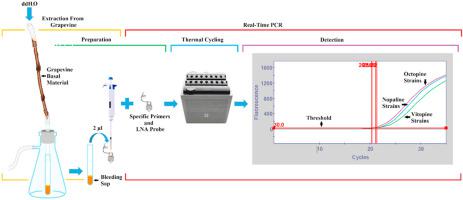Crop Protection ( IF 2.5 ) Pub Date : 2021-03-19 , DOI: 10.1016/j.cropro.2021.105620 Ali Turgut , Hüseyin Basim

|
Crown gall disease caused by Allorhizobium vitis is one of the most destructive diseases in grapevine cultivation from an economical perspective. The bacterial pathogen exists systemically in grapevines and spreads through cuttings used for propagation material obtained from grapevines, living vines, and mother blocks, which poses a high risk for certified grapevine nursery material cultivation, nursery industry, and growers. Therefore, in this study, real-time PCR-based methods were developed for effectively and accurately determining the presence and the density of the bacterial pathogen in grapevine nursery material and the data used for indexing programs. Octopine-, nopaline-, and vitopine-catabolizing A. vitis strain-specific primer and locked nucleic acid (LNA) probe sets were determined depending on the ocs, nos, vis, vitopine iaaM, and vitopine virD2 genes. Primer-probe sets were then used to amplify the octopine synthase gene (62 bp) from octopine strains, the nopaline synthase gene (78 bp) from nopaline strains, and the vitopine synthase gene (60 bp) from vitopine strains, as well as the vitopine iaaM gene (60 bp) and the vitopine virD2 gene (66 bp) of A. vitis. The detection of A. vitis strains from bacterial suspension or extracted plant sap could be achieved within a short time (i.e., 20–25 min) with real-time PCR-based assays using the designed primer and probe sets. For the real-time PCR-based methods, the bacterial cell sensitivity threshold was defined as sensitivity threshold for one bacterial cell and at the DNA level, which was 1.4–1.9 fg. In real-time PCR-based methods, the corresponding PCR efficiencies for octopine and nopaline strains were 97.12% and 97.87%, respectively and for vitopine strains were 94.39%, 96.76%, and 99.01%. In this study, a new real-time PCR-based method was developed that uses the LNA probe, and different opine strains of A. vitis were detected and quantified from vegetative materials of infected grapevine.
中文翻译:

使用锁定核酸探针的实时PCR检测技术的开发,用于检测葡萄中致瘤性别根瘤菌葡萄的章鱼碱,胭脂碱和章鱼碱菌株
从经济的角度来看,由别生根瘤菌葡萄引起的冠disease病是葡萄栽培中最具破坏性的疾病之一。细菌病原体系统地存在于葡萄藤中,并通过用于繁殖从葡萄藤,活葡萄藤和母块获得的材料的插条传播,这对经过认证的葡萄苗圃材料种植,苗圃产业和种植者构成了很高的风险。因此,在这项研究中,开发了基于实时PCR的方法,可以有效,准确地确定葡萄苗圃材料中细菌病原体的存在和密度以及用于索引程序的数据。Octopine-,nopaline-和vitopine分解代谢A.葡萄根据ocs,nos,vis,vitopine iaaM和vitopine virD2基因确定菌株特异性引物和锁定核酸(LNA)探针组。然后使用引物探针组从章鱼碱菌株中扩增出章鱼碱合酶基因(62 bp),从胭脂碱菌株中扩增出胭脂碱合酶基因(78 bp),以及从荚果碱菌株中扩增出荚果碱合酶基因(60 bp)。葡萄球菌的vitopine iaaM基因(60 bp)和vitopine virD2基因(66 bp)。葡萄球菌的检测通过使用设计的引物和探针组进行基于PCR的实时测定,可以在短时间内(即20–25分钟)获得来自细菌悬浮液或提取的植物汁液的菌株。对于基于实时PCR的方法,细菌细胞敏感度阈值定义为一种细菌细胞的敏感度阈值,在DNA水平为1.4–1.9 fg。在基于实时PCR的方法中,章鱼碱和胭脂碱菌株的相应PCR效率分别为97.12%和97.87%,而章鱼碱菌株的相应PCR效率分别为94.39%,96.76%和99.01%。在这项研究中,开发了一种新的基于实时PCR的方法,该方法使用LNA探针,并从受感染葡萄的营养物质中检测和定量了葡萄球菌的不同鸦片菌株。











































 京公网安备 11010802027423号
京公网安备 11010802027423号